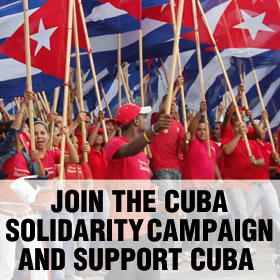Protest in Cuba: Why it failed
CounterPunch | Monday, 22 November 2021 | Click here for original article

The news was…. There was no news.
On November 15, the US media primed us for a repeat of the events of July 11 in Cuba — only more massive and more dramatic.
In July, tens of thousands of Cubans took to the streets to express their frustrations with their government and, more generally, the state of their country and its economy.
In the lead-up to this month’s announced protests, Archipiélago — a broad umbrella of dissident groups led by well-known dramatist Yunior García — boasted a Facebook group of 37,000 members. It publicly identified rallying points around the island where demonstrations would begin that day at 3 pm.
But nothing much happened. Organizers asked Cubans to take to the streets to demand radical changes in the government, but only a handful responded. They invited Cubans to bang pots later that night to show the world their frustration. Even fewer did. Despite predictions of violence and vandalism in the streets, CBS Miami reported only 11 people arrested, with another 50 barricaded in their homes by government agents and supporters. By the next day, García himself, without telling any of his fellow dissidents, decamped to Spain.
What went wrong?
The media knew — or claimed to: “By suppressing protest, Cuba’s government displays its fear of the people” (Washington Post); “Cuban government quashes planned march by protestors” (NBC News); “Cuba Crushes Dissent Ahead of Protest” (New York Times).
The media was not totally wrong. The Cuban government does have a long history of repressing dissent, which it claims is largely fomented by the US, and which it considers an existential threat. (Those claims aren’t wrong either, though their implications rarely get explored in the media.)
Certainly, some Cubans were dissuaded from demonstrating by the large police and military presence on the streets.
But that alone doesn’t explain the lack of outcome.
What did the US media, which generally parrots Washington’s malign interpretation of anything that happens in Cuba, miss in its myopia?
Plenty. Start with some significant events that actually did happen in Cuba on November 15.
On that day, for example, the country’s critically important, pandemic-ravaged tourism industry reopened to fully vaccinated international visitors after 18 brutal months of COVID-19 shutdown. In the first week, international flights to Cuba were scheduled to increase from 67 a week to over 400.
That became possible because Cuba has brought COVID under some level of control again, thanks in part to a massive Cuba-wide vaccination program using vaccines developed in its own labs. Cuban vaccination rates are among the highest in the world. And the number of COVID cases has decreased from a daily average of 10,000 in the summer to 243 the day of the planned protest.
Not coincidentally, November 15 also marked the much-delayed return to in-classroom learning for 700,000 Cuban children, a major return-to-normal milestone that helped buoy spirits.
So too did a series of free concerts and art exhibits to celebrate the upcoming 502nd anniversary of the founding of Havana.
Beyond those markers, there were other pragmatic reasons for Cubans to feel more hopeful as protest day dawned. Venezuela, the major supplier of oil to the island, increased its supplies from 40,000 barrels per day in August to 66,000 in November. Power has become more stable, with fewer blackouts, and the cooler weather has helped ease pressure on the grid.
It is also fair to note that the Cuban government — caught napping in July — learned lessons too. But not — as the US media would have it — simply how to intimidate and control its citizens.
Cuba’s leaders acknowledged many of the frustrations that led to the July protests were legitimate and set about making changes, particularly for women and young people, and those in marginalized zones in larger cities. There are 62 projects in Havana alone as job creation, infrastructure development, housing repair, all became priorities.
The government launched additional economic reforms too, offering greater freedom for self-employment, access to hard currency credits for the private sector and opportunities to collaborate with foreign investment partners. Over 16,000 self-employment projects have since been registered, 416 requests to establish small and medium-sized enterprises approved.
At the same time, the Cuban government launched a massive media campaign to make the case to Cubans and the world — rightly again — that much of what ails the Cuban economy is still the result of the ongoing, never-ending US embargo and US-financed efforts encouraging right-wing regime change of the sort promoted by Miami-centred dissident groups like Archipiélago.
None of this is to suggest Cubans are suddenly universally satisfied with their government or with the pace of change. But it does indicate Cuba’s November “normal” appealed more to Cubans than Yunior Garcia’s call to the barricades.
And that should make us all question what we read and see in the media. Cuba is far more complex, its citizens’ views far more nuanced, than the simplistic media caricature suggests.






